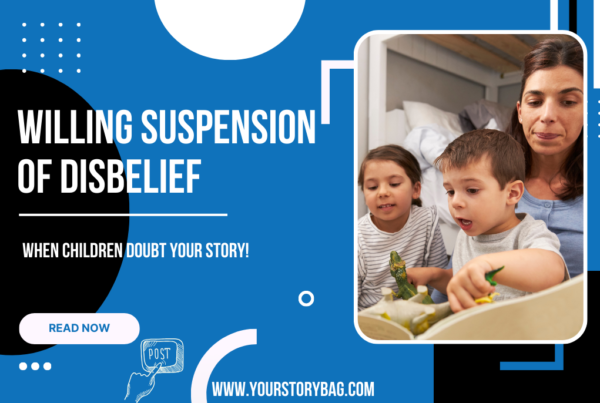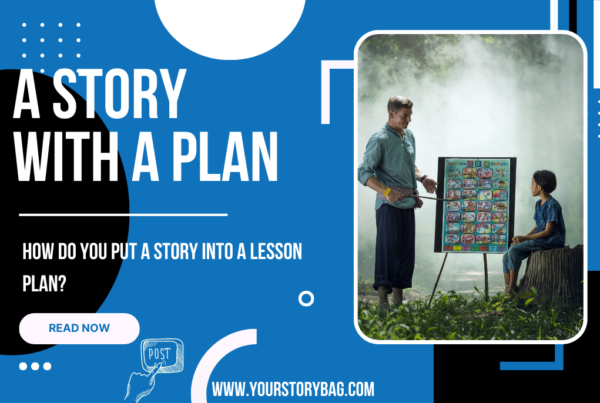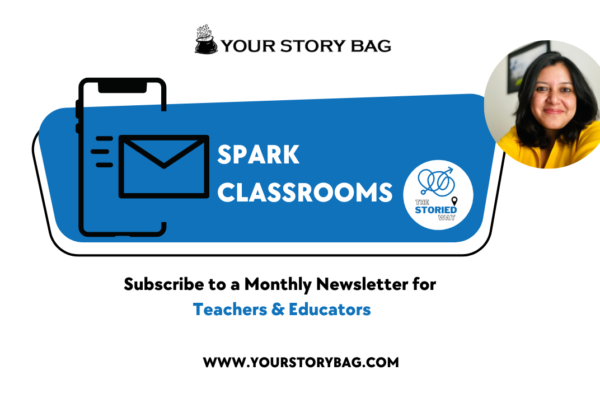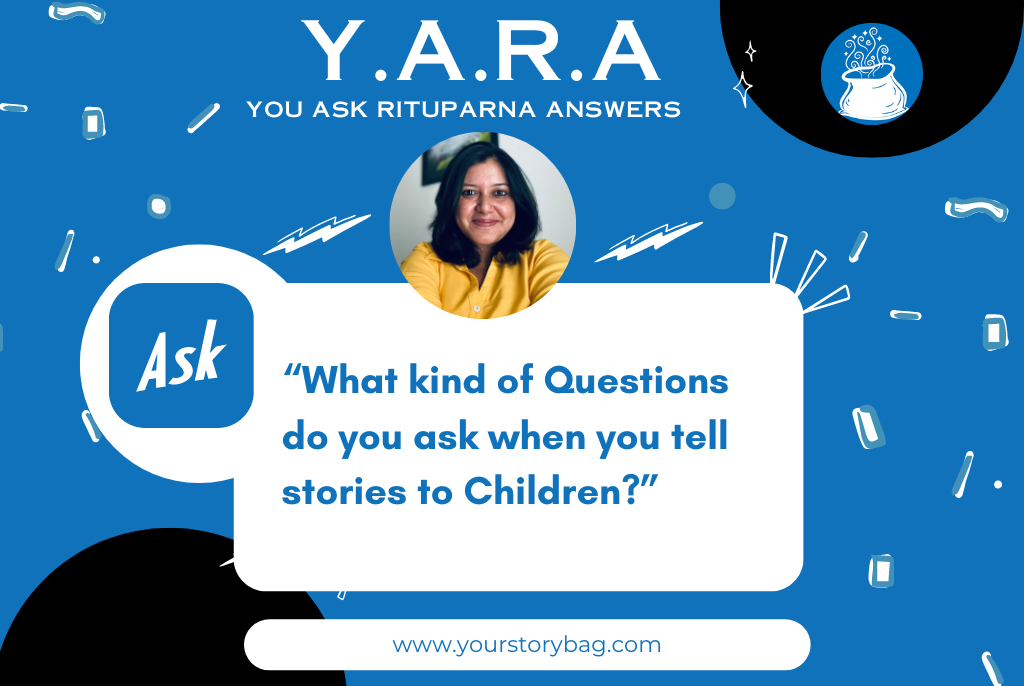
“I am going to tell you a story about ….. Can you guess what it is?”
(I mime. I move my hand to shape a cloud in the air)
Children take turns to guess. After a few turns I throw some hints:
- It can white. It can grey.
- It can look light. It can get heavy.
- It can rise. It can glide. It can float.
This is what I call a HOOK in a story. Once I have the children all thrilled about listening to a story about clouds, I ask them a set of questions that help me know what have they observed about clouds.
Recently, a teacher who is undergoing our Spark Classrooms Program asked me “What kind of Questions do you ask when you tell stories to Children?” She had seen ABC of Storytelling, where Q mentions Question.
I shared a quick answer to her query, and then I thought, why not share our enquiry framework in a detailed post.
For every story we tell, or use as pedagogy, we design an enquiry framework that allows us to entertain, teach and assess children through strategically placed questions along the story line.
Sometimes the questions are embedded as a tool to allow children to learn from their environment, and bring outside-in application of the concept.
I strongly recommend you embed stories all through your story. Not too many, not too few! What is the perfect number of questions? We will get to that soon:
Questions at the start of a story help me assess the knowledge of the child. It gives me the starting point from where we begin our exploration. What follows next, is a set of critical set of questions DURING the story. The key is to remember that the questions have to be short, crisp and should not feel like an interruption in the story.
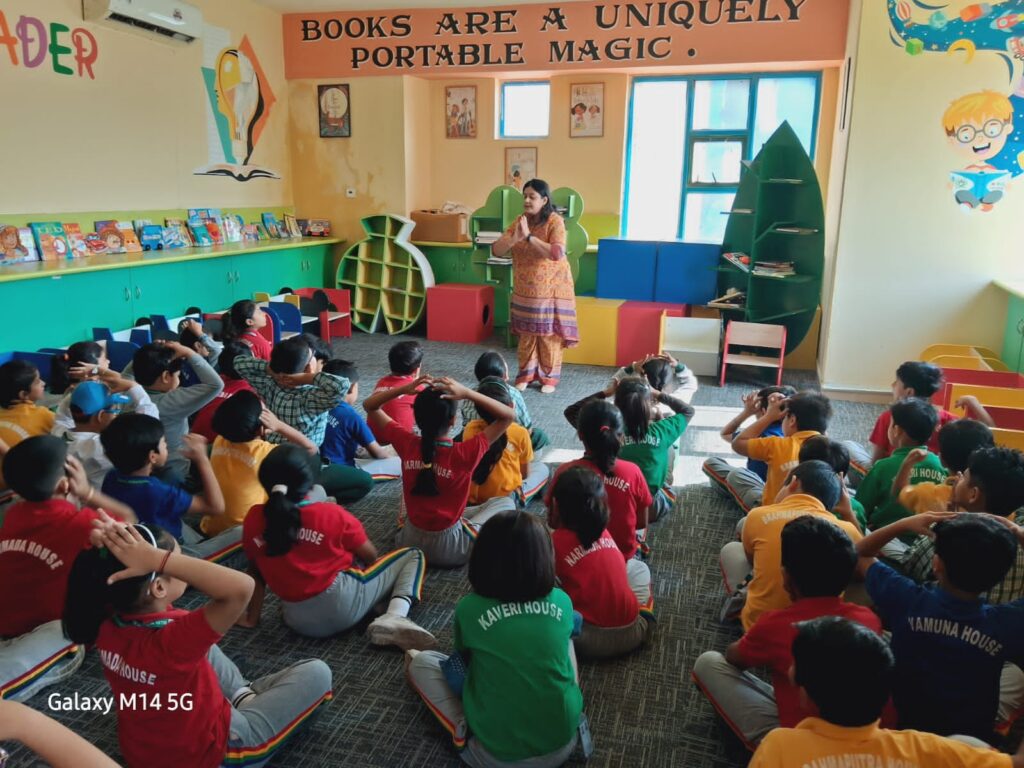
What do we need to listen to stories?: My listeners suggest, “Our thinking brain that asks questions!” Notice they show their heads. This is a picture from our Storytelling Sessions at Delhi World Public School, Noida Extn where we are a Storytelling Partner.
The book referred below: Little Cloud’s Quest by Stephen Aitken and Sylvia Sikundar, published by Katha Books.
Here are some strategies and examples for Storytelling Teachers looking to ace Story Pedagogy:
Pause at Key Moments:
Pause at critical points to ask questions that encourage listeners to think deeper about the story.
Example: “The cloud felt small compared to the big clouds. How long do you think it would take for the little cloud to grow into a big cloud?”
Use Open-Ended Questions:
Ask questions that require more than a yes or no answer to encourage discussion and deeper thinking.
Example: “If the sun turns water into vapour, why are the seas not drying up?”
Relate to Personal Experience:
Connect the story to the listeners’ own lives and experiences to make it more relevant and thought-provoking.
Example: “Call up your relatives in other cities and ask them to describe the cloud they see outside their windows.”
Predict and Hypothesise:
Encourage listeners to predict what might happen next or hypothesize alternative outcomes.
Example: “Why do clouds rest on mountain tops?”
Imagine “What If’s”:
Bring connections between stories or create hypothetical scenarios.
Example: “What if the sun didn’t rise! What would happen to the clouds? How would it impact us?”
Ideal Number of Questions
The ideal number of critical thinking questions depends on the length and complexity of the story, as well as the age and engagement level of the audience. Generally, 3-5 well-placed questions can be effective for a typical storytelling session. When we create story-based lesson plans in Spark Classrooms, I insist teachers write down the exact questions they’d want to ask. This makes it an easy script to follow.
Here’s a breakdown of what works:
- Short Stories (5-10 minutes): 2-3 questions.
- Medium-Length Stories (10-20 minutes): 3-4 questions.
- Longer Stories (20+ minutes): 4-5 questions.
By strategically embedding concept-related questions, a Storytelling Teacher can foster an interactive and reflective session. Not only does it allow the teacher to fully utilise the students prior knowledge, it also allows her to build concept and assess the child based on their understanding and application of the concept.
Want to be a Storytelling Teacher?
Come, let’s Spark Classrooms!
Have you enrolled in ABC of Storytelling, our FREE STORYTELLING COURSE for Teachers, Parents and Storytellers?
Spark Classroom, The Storied Way is a newsletter for School Teachers who are keen to explore Stories in the Classroom.
Join us on Tuesdays (across Social Media) for some interesting conversations around Story Pedagogy, Stories in the Classroom & Storytelling Teachers.
To get the next edition of the Newsletter in your Inbox, SUBSCRIBE HERE


